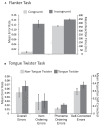Twisting tongues to test for conflict-monitoring in speech production
- PMID: 24795592
- PMCID: PMC3997035
- DOI: 10.3389/fnhum.2014.00206
Twisting tongues to test for conflict-monitoring in speech production
Abstract
A number of recent studies have hypothesized that monitoring in speech production may occur via domain-general mechanisms responsible for the detection of response conflict. Outside of language, two ERP components have consistently been elicited in conflict-inducing tasks (e.g., the flanker task): the stimulus-locked N2 on correct trials, and the response-locked error-related negativity (ERN). The present investigation used these electrophysiological markers to test whether a common response conflict monitor is responsible for monitoring in speech and non-speech tasks. Electroencephalography (EEG) was recorded while participants performed a tongue twister (TT) task and a manual version of the flanker task. In the TT task, people rapidly read sequences of four nonwords arranged in TT and non-TT patterns three times. In the flanker task, people responded with a left/right button press to a center-facing arrow, and conflict was manipulated by the congruency of the flanking arrows. Behavioral results showed typical effects of both tasks, with increased error rates and slower speech onset times for TT relative to non-TT trials and for incongruent relative to congruent flanker trials. In the flanker task, stimulus-locked EEG analyses replicated previous results, with a larger N2 for incongruent relative to congruent trials, and a response-locked ERN. In the TT task, stimulus-locked analyses revealed broad, frontally-distributed differences beginning around 50 ms and lasting until just before speech initiation, with TT trials more negative than non-TT trials; response-locked analyses revealed an ERN. Correlation across these measures showed some correlations within a task, but little evidence of systematic cross-task correlation. Although the present results do not speak against conflict signals from the production system serving as cues to self-monitoring, they are not consistent with signatures of response conflict being mediated by a single, domain-general conflict monitor.
Keywords: ERP/EEG; N2; cognitive control; error-related negativity (ERN); flanker task; monitoring; speech production; tongue twister.
Figures



Similar articles
-
Error-monitoring across social and affective processing contexts.Int J Psychophysiol. 2020 Apr;150:37-49. doi: 10.1016/j.ijpsycho.2020.01.009. Epub 2020 Jan 28. Int J Psychophysiol. 2020. PMID: 32004658
-
Flanker task with equiprobable congruent and incongruent conditions does not elicit the conflict N2.Psychophysiology. 2018 Feb;55(2). doi: 10.1111/psyp.12980. Epub 2017 Aug 28. Psychophysiology. 2018. PMID: 28845513
-
Chronic Exercise as a Modulator of Cognitive Control: Investigating the Electrophysiological Indices of Performance Monitoring.Front Psychol. 2022 Apr 5;13:814199. doi: 10.3389/fpsyg.2022.814199. eCollection 2022. Front Psychol. 2022. PMID: 35450338 Free PMC article.
-
Making sense of all the conflict: a theoretical review and critique of conflict-related ERPs.Int J Psychophysiol. 2014 Sep;93(3):283-97. doi: 10.1016/j.ijpsycho.2014.06.007. Epub 2014 Jun 17. Int J Psychophysiol. 2014. PMID: 24950132 Review.
-
The late posterior negativity in ERP studies of episodic memory: action monitoring and retrieval of attribute conjunctions.Biol Psychol. 2003 Oct;64(1-2):91-117. doi: 10.1016/s0301-0511(03)00104-2. Biol Psychol. 2003. PMID: 14602357 Review.
Cited by
-
A common neural hub resolves syntactic and non-syntactic conflict through cooperation with task-specific networks.Brain Lang. 2017 Mar;166:63-77. doi: 10.1016/j.bandl.2016.12.006. Epub 2017 Jan 18. Brain Lang. 2017. PMID: 28110105 Free PMC article.
-
Pre-output Language Monitoring in Sign Production.J Cogn Neurosci. 2020 Jun;32(6):1079-1091. doi: 10.1162/jocn_a_01542. Epub 2020 Feb 6. J Cogn Neurosci. 2020. PMID: 32027582 Free PMC article.
-
Monitoring of language selection errors in switching: Not all about conflict.PLoS One. 2018 Nov 26;13(11):e0200397. doi: 10.1371/journal.pone.0200397. eCollection 2018. PLoS One. 2018. PMID: 30475803 Free PMC article.
-
Mind what you say-general and specific mechanisms for monitoring in speech production.Front Hum Neurosci. 2014 Jul 21;8:514. doi: 10.3389/fnhum.2014.00514. eCollection 2014. Front Hum Neurosci. 2014. PMID: 25100968 Free PMC article. No abstract available.
-
Parsing the Neural Mechanisms of Short-Term and Long-Term Associations in the Flanker Tasks: An ERP Analysis.Front Behav Neurosci. 2021 Aug 5;15:626907. doi: 10.3389/fnbeh.2021.626907. eCollection 2021. Front Behav Neurosci. 2021. PMID: 34421550 Free PMC article.
References
-
- Baars B. J., Motley M. T., MacKay D. G. (1975). Output editing for lexical status in artificially elicited slips of the tongue. J. Verbal Learn. Verbal Behav. 14 382–391 10.1016/S0022-5371(75)80017-X - DOI
LinkOut - more resources
Full Text Sources
Other Literature Sources

